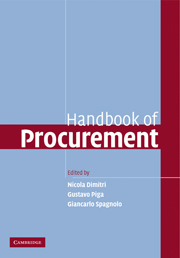Book contents
- Frontmatter
- Contents
- List of figures
- List of tables
- List of contributors
- Preface
- Part I Preliminary Issues
- Part II General Strategic Principles
- Part III Competitive Tendering Strategies
- Part IV Attracting and Screening Participants
- Part V Preventing Collusion and Corruption
- 14 Preventing collusion in procurement
- 15 Bidding rings and the design of anti-collusive measures for auctions and procurements
- 16 Corruption in procurement auctions
- Part VI Dynamic Forces and Innovation
- Glossary
- Index
- References
15 - Bidding rings and the design of anti-collusive measures for auctions and procurements
Published online by Cambridge University Press: 04 November 2009
- Frontmatter
- Contents
- List of figures
- List of tables
- List of contributors
- Preface
- Part I Preliminary Issues
- Part II General Strategic Principles
- Part III Competitive Tendering Strategies
- Part IV Attracting and Screening Participants
- Part V Preventing Collusion and Corruption
- 14 Preventing collusion in procurement
- 15 Bidding rings and the design of anti-collusive measures for auctions and procurements
- 16 Corruption in procurement auctions
- Part VI Dynamic Forces and Innovation
- Glossary
- Index
- References
Summary
Introduction
Since the mid-1990s, the enforcement of competition laws against cartels has drawn considerable attention to the means by which buyers or sellers establish and manage collusive schemes. High-profile lawsuits against cartels in the food additives and vitamins sectors have made public an unprecedented wealth of information about how cartels operate. Complementing this stream of data is a modern body of scholarship that, working extensively with reported judicial decisions and other materials, has provided informative perspectives on the methods of cartel coordination.
For the most part, discussions inspired by modern enforcement developments and scholarly contributions have addressed the optimal design of public policies against cartels. Key focal points for debate have included the formulation of strategies for improving the detection of cartels (e.g., providing inducements for cartel members or employees of cartel members to inform public authorities about the existence of the cartel); the establishment or enhancement of private rights of action to supplement anti-cartel enforcement by public agencies; and the choice of remedies (e.g., civil damages and criminal punishment, including imprisonment for individuals).
In this chapter, we explore the implications of the modern data and literature on cartel coordination with a different orientation. Rather than assess refinements in public enforcement policy, we analyze possibilities for precautions that contracting parties can take independently, without necessarily invoking public laws that condemn cartels, to defeat or discourage collusion by bidders.
- Type
- Chapter
- Information
- Handbook of Procurement , pp. 381 - 411Publisher: Cambridge University PressPrint publication year: 2006
References
- 15
- Cited by



